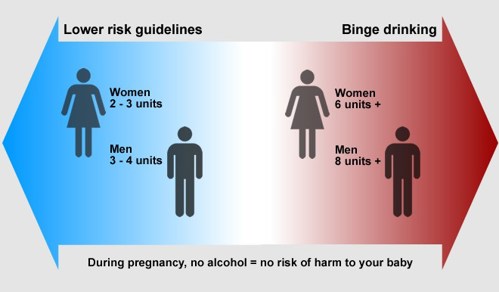Drinking less alcohol can help everyone reduce the risk of certain cancers as well as high blood pressure, heart disease, and liver problems.
It can also help improve mood and sleep, increase energy for physical activity, and reduce nausea and a sore mouth during chemotherapy and radiotherapy.
During cancer treatment it's important that our staff:
- Identify if your drinking is likely to effect your treatment and recovery via a simple questionnaire (AUDIT C)
- Guide you on the changes you can make to either take a break or reduce alcohol use to a lower risk level.
- If you find it hard to take a break or reduce we would be able refer you to specialist services in the community or to a member of our Psycho-Oncology staff for support during any hospital stay here.
Let's look at the facts….
How much is too much?

Common myth - I can handle my drink so the guidelines don't apply to me.
Fact - If you feel like you can "handle your drink" you probably have developed a tolerance to alcohol. With time and regular use, a person often drinks more to get the old effect. You are more at risk with every additional unit above the daily guidelines.
Common myth - Red wine is good for your heart whatever your age.
Fact - Only men over the age of 40 and women who have been through the menopause can benefit from one or two units in a day.
Common myth - Having a drink will help me sleep.
Fact - Alcohol may bring on tiredness but with time it disrupts normal sleep patterns. A person often wakes up in the second half of the night.
Common myth - Binge drinking only affects young people.
Fact - Binge drinking is defined as drinking more than 6 units in one day for women and more than 8 units in one day for men. At any age, after an episode of binge drinking it is advisable to refrain from drinking for 48 hours to allow tissues to recover.
What is a unit of alcohol?
- One unit = 8g of 10ml of ethanol.
The number of units in an alcoholic drink depends on the amount (ml) and the % strength of the drink.
The following formula is used to quickly calculate the unit content:
- abv multiplied by ml divided by 1000 = units
Example of 12% wine 250ml glass
- 12 x 250 = 3000, divided by 1000, = 3 units
One Drink is rarely One unit
- 25ml single measure of spirits - 40% abv - 1 unit
- 275ml bottle of Alcopop - 5% abv - 1.4 units
- 1 pint of lager/cider - 5.2% abv - 3 units
- 250ml glass of wine - 12% abv - 3 units
- 500ml can of super strength lager - 9% abv - 4.5 units
- 750ml bottle of wine - 12% abv - 9 units
- 3 litres of strong cider - 7.5% abv - 22.5 units
- 70cl bottle of vodka - 40% abv - 28 units
Low or non alcoholic drinks are becoming more popular as a spacer between alcoholic drinks or to help take a break from alcohol during chemotherapy and radiotherapy.
There are some great tasting non-alcoholic wines and beers on the market. The stress of diagnosis and the demands of treatment can increase use of alcohol - if you think this is happening please contact our Alcohol Advice worker can help you look at making changes so you stay within lower risk limits.
- Alcohol Advice Support worker: Tel no. 0161 446 8236
- Drink Smart - Safer drinking in later life
